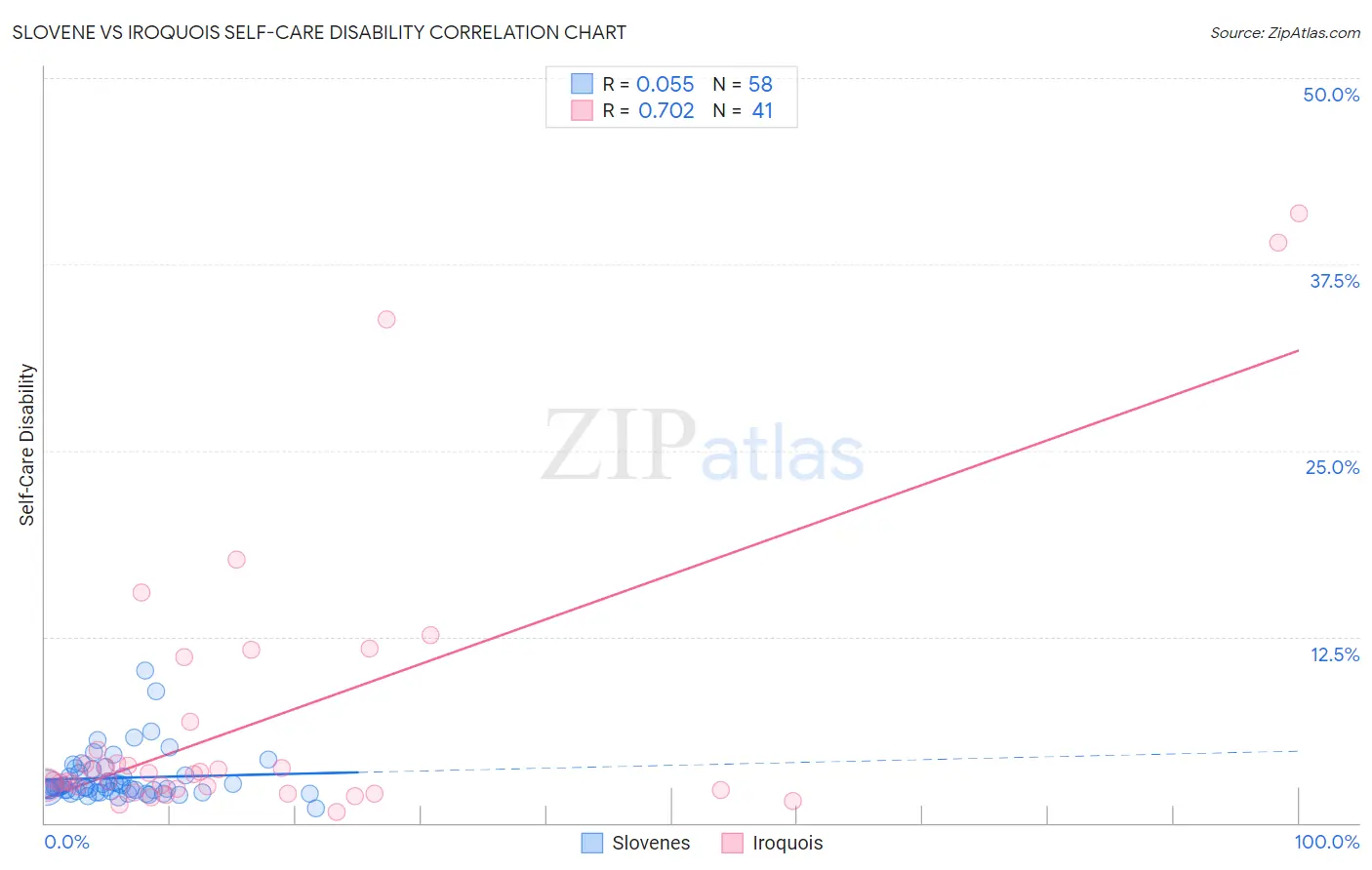Slovene vs Iroquois Self-Care Disability
COMPARE
Slovene
Iroquois
Self-Care Disability
Self-Care Disability Comparison
Slovenes
Iroquois
2.4%
SELF-CARE DISABILITY
94.1/ 100
METRIC RATING
109th/ 347
METRIC RANK
2.7%
SELF-CARE DISABILITY
0.1/ 100
METRIC RATING
279th/ 347
METRIC RANK
Slovene vs Iroquois Self-Care Disability Correlation Chart
The statistical analysis conducted on geographies consisting of 261,131,209 people shows a slight positive correlation between the proportion of Slovenes and percentage of population with self-care disability in the United States with a correlation coefficient (R) of 0.055 and weighted average of 2.4%. Similarly, the statistical analysis conducted on geographies consisting of 207,147,261 people shows a strong positive correlation between the proportion of Iroquois and percentage of population with self-care disability in the United States with a correlation coefficient (R) of 0.702 and weighted average of 2.7%, a difference of 12.7%.

Self-Care Disability Correlation Summary
| Measurement | Slovene | Iroquois |
| Minimum | 1.00% | 0.76% |
| Maximum | 10.2% | 40.9% |
| Range | 9.2% | 40.1% |
| Mean | 3.0% | 7.0% |
| Median | 2.4% | 3.3% |
| Interquartile 25% (IQ1) | 2.1% | 2.3% |
| Interquartile 75% (IQ3) | 3.4% | 5.9% |
| Interquartile Range (IQR) | 1.2% | 3.6% |
| Standard Deviation (Sample) | 1.6% | 9.7% |
| Standard Deviation (Population) | 1.6% | 9.6% |
Similar Demographics by Self-Care Disability
Demographics Similar to Slovenes by Self-Care Disability
In terms of self-care disability, the demographic groups most similar to Slovenes are Greek (2.4%, a difference of 0.010%), British (2.4%, a difference of 0.040%), Immigrants from Indonesia (2.4%, a difference of 0.050%), Carpatho Rusyn (2.4%, a difference of 0.060%), and Immigrants from Africa (2.4%, a difference of 0.080%).
| Demographics | Rating | Rank | Self-Care Disability |
| Croatians | 95.0 /100 | #102 | Exceptional 2.4% |
| Alsatians | 94.9 /100 | #103 | Exceptional 2.4% |
| Bhutanese | 94.5 /100 | #104 | Exceptional 2.4% |
| Carpatho Rusyns | 94.4 /100 | #105 | Exceptional 2.4% |
| Immigrants | Indonesia | 94.3 /100 | #106 | Exceptional 2.4% |
| British | 94.3 /100 | #107 | Exceptional 2.4% |
| Greeks | 94.1 /100 | #108 | Exceptional 2.4% |
| Slovenes | 94.1 /100 | #109 | Exceptional 2.4% |
| Immigrants | Africa | 93.7 /100 | #110 | Exceptional 2.4% |
| Serbians | 93.6 /100 | #111 | Exceptional 2.4% |
| Scandinavians | 93.5 /100 | #112 | Exceptional 2.4% |
| South Americans | 93.2 /100 | #113 | Exceptional 2.4% |
| Immigrants | North Macedonia | 93.1 /100 | #114 | Exceptional 2.4% |
| Immigrants | Hong Kong | 93.1 /100 | #115 | Exceptional 2.4% |
| Northern Europeans | 92.9 /100 | #116 | Exceptional 2.4% |
Demographics Similar to Iroquois by Self-Care Disability
In terms of self-care disability, the demographic groups most similar to Iroquois are Hispanic or Latino (2.7%, a difference of 0.020%), Ottawa (2.7%, a difference of 0.10%), Immigrants from Ukraine (2.7%, a difference of 0.18%), Immigrants from Iraq (2.7%, a difference of 0.18%), and Apache (2.7%, a difference of 0.20%).
| Demographics | Rating | Rank | Self-Care Disability |
| Immigrants | Laos | 0.1 /100 | #272 | Tragic 2.7% |
| Mexicans | 0.1 /100 | #273 | Tragic 2.7% |
| Yakama | 0.1 /100 | #274 | Tragic 2.7% |
| Immigrants | Trinidad and Tobago | 0.1 /100 | #275 | Tragic 2.7% |
| Japanese | 0.1 /100 | #276 | Tragic 2.7% |
| Immigrants | Ukraine | 0.1 /100 | #277 | Tragic 2.7% |
| Ottawa | 0.1 /100 | #278 | Tragic 2.7% |
| Iroquois | 0.1 /100 | #279 | Tragic 2.7% |
| Hispanics or Latinos | 0.1 /100 | #280 | Tragic 2.7% |
| Immigrants | Iraq | 0.0 /100 | #281 | Tragic 2.7% |
| Apache | 0.0 /100 | #282 | Tragic 2.7% |
| Delaware | 0.0 /100 | #283 | Tragic 2.7% |
| Fijians | 0.0 /100 | #284 | Tragic 2.7% |
| Jamaicans | 0.0 /100 | #285 | Tragic 2.7% |
| French American Indians | 0.0 /100 | #286 | Tragic 2.7% |